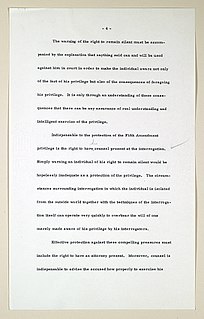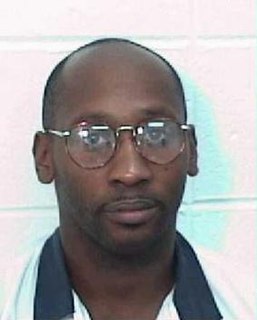
In the United States, the Miranda warning is a type of notification customarily given by police to criminal suspects in police custody advising them of their right to silence; that is, their right to refuse to answer questions or provide information to law enforcement or other officials. These rights are often referred to as Miranda rights. The purpose of such notification is to preserve the admissibility of their statements made during custodial interrogation in later criminal proceedings.

The Sixth Amendment to the United States Constitution sets forth rights related to criminal prosecutions. It was ratified in 1791 as part of the United States Bill of Rights. The Supreme Court has applied the protections of this amendment to the states through the Due Process Clause of the Fourteenth Amendment.
Miranda v. Arizona, 384 U.S. 436 (1966), was a landmark decision of the U.S. Supreme Court in which the Court ruled that the Fifth Amendment to the U.S. Constitution restricts prosecutors from using a person's statements made in response to interrogation in police custody as evidence at their trial unless they can show that the person was informed of the right to consult with an attorney before and during questioning, and of the right against self-incrimination before police questioning, and that the defendant not only understood these rights, but voluntarily waived them.
Hearsay is testimony from a witness under oath who is reciting an out-of-court statement that is being offered to prove the truth of the matter asserted.
Maryland v. Craig, 497 U.S. 836 (1990), was a U.S. Supreme Court case involving the Sixth Amendment. The Court ruled that the Sixth Amendment's Confrontation Clause, which provides criminal defendants with the right to confront witnesses against them, did not bar the use of one-way closed-circuit television to present testimony by an alleged child sex abuse victim.
Crawford v. Washington, 541 U.S. 36 (2004), is a United States Supreme Court decision that reformulated the standard for determining when the admission of hearsay statements in criminal cases is permitted under the Confrontation Clause of the Sixth Amendment. The Court held that prior testimonial statements of witnesses who have since become unavailable may not be admitted without cross-examination.
Self-incrimination is the act of exposing oneself generally, by making a statement, "to an accusation or charge of crime; to involve oneself or another [person] in a criminal prosecution or the danger thereof"..
David Rice and Edward Poindexter were charged and convicted of the murder of Omaha Police Officer Larry Minard. Minard died when a suitcase bomb containing dynamite exploded in a North Omaha home on August 17, 1970. Officer John Tess was also injured in the explosion. Rice died on March 11, 2016. He was 68 years old and had been in poor health.
The Confrontation Clause of the Sixth Amendment to the United States Constitution provides that "in all criminal prosecutions, the accused shall enjoy the right…to be confronted with the witnesses against him." The right only applies to criminal prosecutions, not civil cases or other proceedings. Generally, the right is to have a face-to-face confrontation with witnesses who are offering testimonial evidence against the accused in the form of cross-examination during a trial. The Fourteenth Amendment makes the right to confrontation applicable to the states and not just the federal government.
Massiah v. United States, 377 U.S. 201 (1964), was a case in which the Supreme Court of the United States held that the Sixth Amendment to the United States Constitution prohibits the government from eliciting statements from the defendant about themselves after the point that the Sixth Amendment right to counsel attaches.

Troy Anthony Davis was a man convicted of and executed for the August 19, 1989 murder of police officer Mark MacPhail in Savannah, Georgia. MacPhail was working as a security guard at a Burger King restaurant and was intervening to defend a man being assaulted by Davis in a nearby parking lot when he was murdered. During Davis's 1991 trial, seven witnesses testified they had seen Davis shoot MacPhail, and two others testified Davis had confessed the murder to them. There were 34 witnesses who testified for the prosecution, and six others for the defense, including Davis. Although the murder weapon was not recovered, ballistic evidence presented at trial linked bullets recovered at or near the scene to those at another shooting in which Davis was also charged. He was convicted of murder and various lesser charges, including the earlier shooting, and was sentenced to death in August 1991.
Ohio v. Roberts, 448 U.S. 56 (1980), is a United States Supreme Court decision dealing with the Confrontation Clause of the Sixth Amendment to the United States Constitution.
Whorton v. Bockting, 549 U.S. 406 (2007), was a United States Supreme Court case about the application of the Confrontation Clause and whether Crawford v. Washington (2006) applied retroactively. Justice Samuel Alito, writing for a unanimous Court, ruled that Crawford did not apply retroactively.
Franks v. Delaware, 438 U.S. 154 (1978), is a United States Supreme Court case dealing with defendants' rights to challenge evidence collected on the basis of a warrant granted on the basis of a false statement. The court held that where a warrant affidavit contains a statement, necessary to the finding of probable cause, that is demonstrated to be both false and included by an affiant knowingly and intentionally, or with reckless disregard for the truth, the warrant is not valid.
Melendez-Diaz v. Massachusetts, 557 U.S. 305 (2009), is a United States Supreme Court case in which the Court held that it was a violation of the Sixth Amendment right of confrontation for a prosecutor to submit a chemical drug test report without the testimony of the person who performed the test. While the court ruled that the then-common practice of submitting these reports without testimony was unconstitutional, it also held that so called "notice-and-demand" statutes are constitutional. A state would not violate the Constitution through a "notice-and-demand" statute by both putting the defendant on notice that the prosecution would submit a chemical drug test report without the testimony of the scientist and also giving the defendant sufficient time to raise an objection.
Evidence-based prosecution' refers to a collection of techniques utilized by prosecutors in domestic violence cases to convict abusers without the cooperation of an alleged victim. It is widely practiced within the American legal system by specialized prosecutors and state's attorneys and relies on utilizing a variety of evidence to prove the guilt of an abuser with limited or adverse participation by the abuser's victim, or even no participation at all.
Giles v. California, 554 U.S. 353 (2008), was a case decided by the Supreme Court of the United States that held that for testimonial statements to be admissible under the forfeiture exception to hearsay, the defendant must have intended to make the witness unavailable for trial.
Michigan v. Bryant, 562 U.S. 344 (2011), was a United States Supreme Court case in which the Court further developed the "primary purpose" test to determine whether statements are "testimonial" for Confrontation Clause purposes. In Bryant, the Court expanded upon the test first articulated in Davis v. Washington, "addressing for the first time circumstances in which the 'ongoing emergency' discussed in Davis extended to a potential threat to the respond police and the public at large."
Bullcoming v. New Mexico, 564 U.S. 647 (2011), is a significant 6th Amendment Confrontation Clause case decided by the United States Supreme Court. On June 23, 2011, the Supreme Court considered the issue whether a defendant's Confrontation Clause rights extend to a non-testifying laboratory analyst whose supervisor testifies as to test results that the analyst transcribed from a machine. In a five to four decision authored by Justice Ginsburg, the Court held that the second surrogate analyst could not testify about the testimonial statements in the forensic report of the certifying analyst under the Confrontation Clause.

The United States Constitution contains several provisions regarding the law of criminal procedure.




